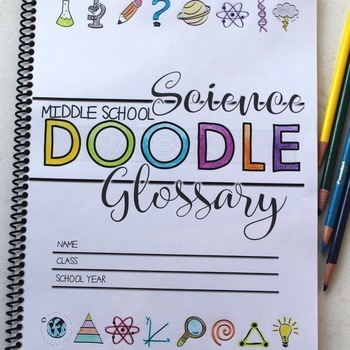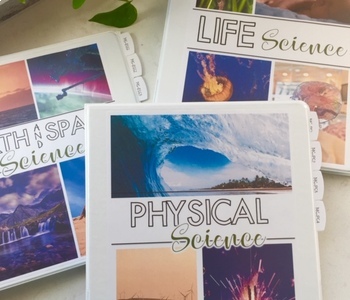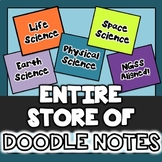NGSS Middle School Science Doodle Notes Bundle
- Zip
- Easel Activity
What educators are saying
Products in this Bundle (49)
showing 1-5 of 49 products
Bonus
Also included in
- This doodle note bundle includes a huge variety of middle school science notes. These doodle notes have been used in my classroom and so many others. They will engage your students and save you hours of time!This product is listed at a 30% discount. Any new doodle note resources added to my TpT stoPrice $323.11Original Price $403.89Save $80.78
Description
Doodle notes to help build NGSS vocabulary skills. Use these science notes to parallel your lessons and add visual triggers to improve memory of content. These doodle notes specifically address the NGSS standards for middle school, while providing concrete visuals to support learners of all abilities. Each page specifically notes the Next Generation Science Standard being addressed!
This can be used as a bellringer, classwork, assessment prep and can be teacher-led or done independently or in small groups. Students complete concise doodle tasks for each big idea, building the vocabulary skills needed to be successful with each standard.
Each file comes with pdf pages to print for your students, teacher answer keys and links to the interactive versions. The interactive versions allow your students to do independent work (perfect for bellringers) by providing videos and text to help them find all the information needed for each doodle task.
This is a huge doodle note set for middle school science. It covers EVERY Life, Earth and Physical Science standard! In addition to classroom use, it is an ideal way to cover and review content for homeschool families!
Be sure to open the preview and watch the preview video to get an inside view of the materials before your purchase!
This 150+ page doodle note bundle includes:
Physical Science (Newly updated to include interactive link pages)
MS Physical Science 1 Matter and Interactions (5 Doodle Pages, 2 Versions and an answer key)
MS Physical Science 2 Motion and Stability (5 Doodle Pages, 2 Versions and answer key)
MS Physical Science 3 Energy (5 Doodle Pages, 2 Versions and answer key)
MS Physical Science 4 Waves (8 Doodle Pages, 2 Versions and answer key)
Earth and Space Science
MS Earth and Space 1 Earth's Place in the Universe 15 Doodle Pages (plus answer keys)
MS Earth and Space 2 Earth's Systems (30 Doodle Pages, 2 Versions and answer key)
MS Earth and Space 3 Human Impact (15 Doodle Pages, 2 Versions and answer keys)
Life Science (Newly updated with interactive link pages)
MS Life Science 1 Molecules to Organisms (40 Doodle Pages, 2 Versions and answer keys)
MS Life Science 2 Ecosystem Interactions (14 Doodle Pages, 2 Versions and answer keys)
MS Life Science 3 Heredity and Inheritance (6 Doodle Pages, 2 Versions and an answer key)
MS Life Science 4 Biological Evolution (10 Doodle Pages, 2 Versions and an answer key)
Bonus File: All 5th Grade NGSS Vocabulary (great for Middle School Teachers to use a REVIEW!) 38 Doodle Pages (Plus 2 versions and an answer key)
Happy Doodling :)
Stay tuned for additions. Remember, once you own this file all additions and updatre are free for you! :)






